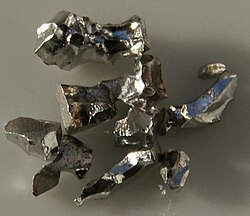Iridium
Iridium was discovered in 1803 among insoluble impurities in natural platinum. Smithson Tennant, the primary discoverer, named the iridium for the goddess Iris, personification of the rainbow, because of the striking and diverse colors of its salts. Iridium is one of the rarest elements in the Earth's crust, with annual production and consumption of only three tonnes. 191Ir and 193Ir are the only two naturally occurring isotopes of iridium as well as the only stable isotopes; the latter is the more abundant of the two.
The most important iridium compounds in use are the salts and acids it forms with chlorine, though iridium also forms a number of organometallic compounds used in industrial catalysis, and in research. Iridium metal is employed when high corrosion resistance at high temperatures is needed, as in high-end spark plugs, crucibles for recrystallization of semiconductors at high temperatures, and electrodes for the production of chlorine in the chloralkali process. Iridium radioisotopes are used in some radioisotope thermoelectric generators.
Iridium is found in meteorites with an abundance much higher than its average abundance in the Earth's crust. For this reason the unusually high abundance of iridium in the clay layer at the Cretaceous–Paleogene boundary gave rise to the Alvarez hypothesis that the impact of a massive extraterrestrial object caused the extinction of dinosaurs and many other species 65 million years ago. It is thought that the total amount of iridium in the planet Earth is much higher than that observed in crustal rocks, but as with other platinum group metals, the high density and tendency of iridium to bond with iron caused most iridium to descend below the crust when the planet was young and still molten.
Occurrence
Iridium is one of the least abundant elements in the Earth's crust, having an average mass fraction of 0.001 ppm in crustal rock; gold is 40 times more abundant, platinum is 10 times more abundant, and silver and mercury are 80 times more abundant. Tellurium is about as abundant as iridium, and only three naturally occurring stable elements are less abundant: rhenium, ruthenium, and rhodium, iridium being 10 times more abundant than the last two. In contrast to its low abundance in crustal rock, iridium is relatively common in meteorites, with concentrations of 0.5 ppm or more. It is thought that the overall concentration of iridium on Earth is much higher than what is observed in crustal rocks, but because of the density and siderophilic ("iron-loving") character of iridium, it descended below the crust and into the Earth's core when the planet was still molten.
Iridium is found in nature as an uncombined element or in natural alloys; especially the iridium–osmium alloys, osmiridium (osmium rich), and iridiosmium (iridium rich).[9] In the nickel and copper deposits the platinum group metals occur as sulfides (i.e. (Pt,Pd)S), tellurides (i.e. PtBiTe), antimonides (PdSb), and arsenides (i.e. PtAs2). In all of these compounds platinum is exchanged by a small amount of iridium and osmium. As with all of the platinum group metals, iridium can be found naturally in alloys with raw nickel or raw copper.
Within the Earth's crust, iridium is found at highest concentrations in three types of geologic structure: igneous deposits (crustal intrusions from below), impact craters, and deposits reworked from one of the former structures. The largest known primary reserves are in the Bushveld igneous complex in South Africa, though the large copper–nickel deposits near Norilsk in Russia, and the Sudbury Basin in Canada are also significant sources of iridium. Smaller reserves are found in the United States. Iridium is also found in secondary deposits, combined with platinum and other platinum group metals in alluvial deposits. The alluvial deposits used by pre-Columbian people in the Chocó Department of Colombia are still a source for platinum-group metals. As of 2003 the world reserves had not been estimated.
| Symbol | Ir | |
| Atomic Number | 77 | |
| Atomic Weight | 192.22 | |
| Oxidation States | +3,+4 | |
| Electronegativity, Pauling | 2.28 | |
| State at RT | solid | |
| Melting Point, K | 2683 | |
| Boiling Point, K | 4403 |
Appearance and Characteristics
Harmful effects:
Iridium is considered to be of low toxicity.
Iridium in powder form is a known irritant and is a fire hazard.
Characteristics:
- Iridium is a rare, hard, lustrous, brittle, very dense platinum-like metal.
- Chemically it is very unreactive.
- It is the most corrosion-resistant metal known and it resists attack by any acid.
- Iridium is attacked by molten salts such as sodium chloride (NaCl) and sodium cyanide (NaCN).
- Iridium is generally credited with being the second densest element (after osmium) based on measured density, although calculations involving the space lattices of the elements show that iridium is denser.
Uses of Iridium
- The main use of iridium is as a hardening agent for platinum alloys.
- With osmium, it forms an alloy that is used for tipping pens, and compass bearings.
- Iridium is used in making crucibles and other equipment that is used at high temperatures.
- It is also used to make heavy-duty electrical contacts.
- Iridium was used in making the international standard kilogram, which is an alloy of 90% platinum and 10% iridium.
- Radioactive isotopes of iridium are used in radiation therapy for the treatment of cancer.
